Shopping Food Drink | Fashion | Carnival | Books | Glass Beads Jewels | Art Objects | Useful
Food Drink Rialto Market | Pasta | Ice Cream | Coffee Roaster | Charcuterie Cheeses | Wine | Pastry
Rialto Market Pescheria Fish | Erbaria Fruit Vegetables
The Rialto fish market: La Pescaria or Pescheria

Rialto Fish Market Amid the cries of seagulls hoping for a slice of the feast, stands the fish market, the Pescaria or Pescheria as it is known here, at the very end of the Rialto island.
The origins of the Pescaria market date back to at least the 13th century, as recounted in a chronicle of the time.
In the early days, Pescaria was located next to the Rialto Bridge.
But it must have bothered the nostrils and the peace and quiet of the nobles who were there to manage their banking business, since the Rialto district, at the same time, was also the district of the banks, the banco giro.
So it was decided to move the Pescaria market in 1459.
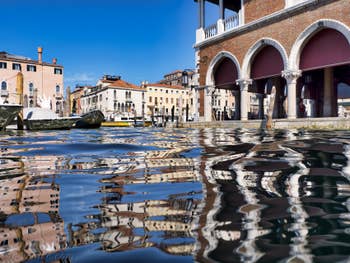
The Pescheria of the Rialto market in Venice The Pescheria du Rialto was first set up where the Erbaria fruit, vegetable and flower market is held today, before moving a few dozen metres to its current location along the Río de la Becarie, between the Campo de la Beccaria and the Grand Canal.
A decree of the Republic of Venice, dated 1531 also tells us that at that time, strange as it may seem, not only fish but also birds were sold there.
And this mix lasted for several centuries.
The pescheria, like the entire Rialto district, suffered numerous fires throughout its history, forcing successive rebuilds of its fish market.
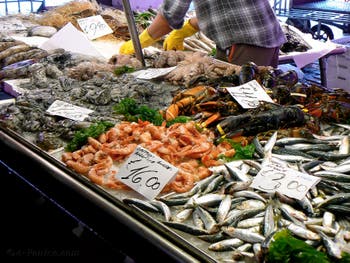
The Rialto Fish Market This is the fish market that occupies the site of the former Palazzo Querini Ca' Mazor, a palace that was partly razed to the ground after the Tiepolo conspiracy in 1310 against the Republic.
What was left of the Querini's houses was transformed in 1339 into butchers' shops.
In 1884 the Pescaria was rebuilt once more and then had an iron roof in the Baroque style.
Finally in 1907 the current brick and marble buildings of the Pescaria were built, starting at the campo de la Beccarie and ending at the corner of the rio de la Becarie and the Grand Canal.
It is this Pescheria Nuova that you can see today, built in a pseudo-Venetian Gothic style.
The architect of this new Pescheria was Domenico Rupolo while Cesare Laurenti created the sculpture depicting Saint Peter, a sculpture that can be seen at the corner of the Pescheria overlooking the Grand Canal.
Rialto fish market, the Pescaria, history of fish sales in Venice

The Grand Canal and the Pescaria in Venice The Republic of Venice had thousands of fishermen, particularly on the islands surrounding it.
However, the sale of fish was highly regulated and by the end of the 19th century there were just under 160 authorised dealers.
At that time, the right to sell fish was reserved for older fishermen to ensure they had an income for the rest of their lives.
You had to be at least fifty years old and have been a fisherman for more than twenty years to obtain the right to sell fish in Venice at the end of the nineteenth century.
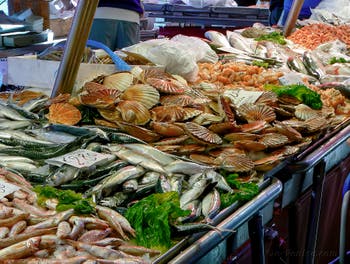
Rialto Fish Market The organisation of fishing and the sale of fish was regulated in Venice as early as October 1227 and controlled by the "Giustizia Vecchia" which was the administrative body responsible at the time for all controls on food products sold in Venice.
As far as the sale of fish was concerned, the Giustizia Vecchia also monitored the hygiene of the points of sale, but also, upstream, on the fishermen's side, the dates authorised for fishing as well as the nets and other means of catching the fish.
A document from the same year 1227, the Capitulare de piscatoribus, also laid down the rules of conduct for the guild of fish dealers in Venice.

The Rialto Fish Market Fish merchants also had to sell the fish in specific places, "al Palo" namely near the mast where the Rialto market stood. The purpose of these controls was to prevent adulteration and speculation in the sale of fish. Fish merchants were obliged to buy their goods only from fishermen identified by the Giustizia Vecchia.
The concern to avoid speculation on prices was constant in Venice, and in the 18th century, fish sales prices were fixed every two months between fishermen, fishpond owners and fishing bosses.
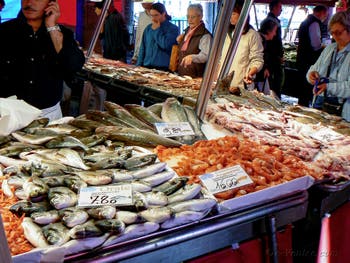
Rialto Fish Market Resellers were not allowed to set up companies with more than two people or have any other sales stall apart from their own.
But if the merchants themselves had to be controlled, so did the fishermen.
So, in the 18th century, the Giustizia Vecchia issued new regulations prohibiting Venetians from buying their fish "by the boat" directly from the fishermen.
As with all the trades in Venice, the fishmongers were organised into brotherhoods and therefore had their own Scuola, dedicated to Saint Albert and located outside the church of the Beate Vergine del Carmine, where they met.
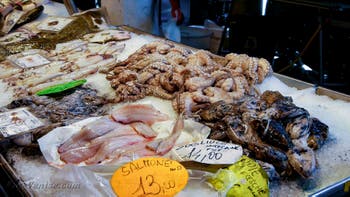
Rialto Fish Market The fishermen's brotherhood, whose elected head was called the Gastaldo, collected taxes on fishing boats to be able to meet the brotherhood's operating needs but also to be able to provide financial assistance to fishermen in difficulty.
The operating rules of the brotherhood, but also the activities of fishing and selling fish, were the subject of statutes and rules internal to the brotherhood, very precise and enshrined in the madriegola, the code of practice of the brotherhood.
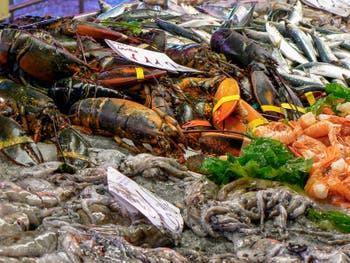
Rialto Fish Market Returning to the colourful market that is the Pescheria del Rialto, let's hear from the writers who enjoyed it long before us.
The most complete bazaar
"There are all kinds of these merchants: fish merchants, vegetable merchants, cheese merchants, wine merchants, fruit merchants, clothing merchants, watch and fake jewellery merchants, bakers, butchers, cobblers, what do I know!
The most complete bazaar. [...]
You are in the middle of a teeming crowd of men and women who come and go amid a deafening noise of shouting and talking.
Every type, every beauty and every ugliness crosses and intertwines. You are stunned, dumbfounded."
Abbé Paul Barbier - Italy 1893
The old fisherman of Chioggia
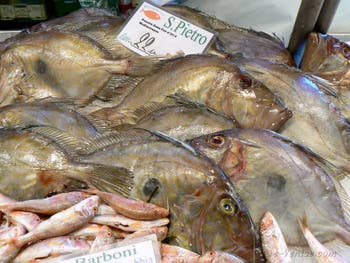
Rialto Fish Market
"We cross the Rialto Bridge, and here we are at the fish market; it is resplendent with the finest fish from the Adriatic: they are pyramids of sturgeon and turbot, ramparts of trillium and sea bream, bastions of exquisite oysters, sea urchins and frutti di mare.
The old fisherman from Chioggia I mentioned greets me and smiles; he says to his companions: "Ecco la Francesa che ama Venezia".
I remark to M. Baschet that the confraternity of ideas populates the solitude of travellers; I no longer feel alone and a stranger in Venice; these good people know me without knowing my name and would protect me if necessary."
Louise Colet - L'Italie des italiens 1862
Fresh tuna comes in red slices
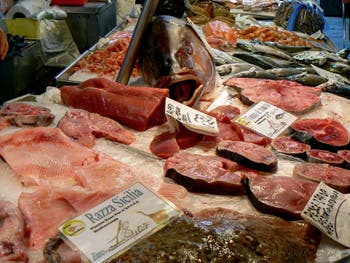
Rialto Fish Market
"There is always, near the Rialto, a tumult of boats and gondolas, and stagnant islands of moored craft drying their tawny sails sometimes crossed by a large cross. [...]
On either side of the Rialto are the ancient Fondaco dei Tedeschi, whose walls are coloured in uncertain shades, revealing frescoes by Titian and Tintoretto, like dreams about to fade away; the fish market, the herbal market and the old and new factories of Scarpagnino and Sansovino, close to falling into ruins, where various magistracies are based.
These reddish factories, degraded, glazed with admirable tones by dilapidation and neglect, must be the despair of the town council and the joy of painters.
Under their arcades, moreover, teems an active and noisy population, going up and down, coming and going, selling and buying, laughing and chirping: there fresh tuna is cut into red slices, and mussels, oysters, crabs, prawns are carried away in baskets."
Théophile Gautier - Italia 1855
The perpetual landing of supplies
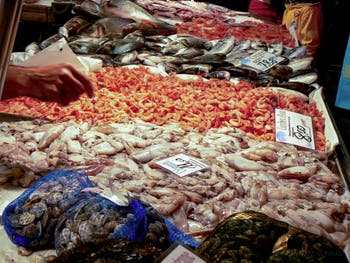
Rialto Fish Market
"I easily found the Grand Canal and the main bridge called Rialto, which consists of a single white marble arch.
The canal is dotted with boats that come to supply the city.
The perpetual unloading of these supplies and the gondolas swarming on all sides make for a sight as singular as it is lively."
Goethe - Memoirs 1786
Little fish so white, so silvery, so pearly...
"We also remember certain fish stalls covered with little fish so white, so silvery, so pearly, that we would have liked to swallow them raw, in the manner of the ichthyophagous of the South Sea, for fear of spoiling their shades, and which made us understand that barbarism of ancient feasts, which consisted of seeing moray eels die in crystal vases, in order to enjoy the opaline hues whose agony diapered them."
Théophile Gautier - Italia 1855
The opening times and days of the Pescaria Fish Market
To take full advantage of all the Venetian life teeming here and the beauty of the Pescheria stalls, we recommend getting there early.And as the Venetians say, "the fish has 24 lives and loses one every hour!" All the fish sold here was caught during the night, so if you go early in the morning, your fish may still have most of its lives left!
After 11 a.m. (except on Saturdays when the market is active until midday), even if a few traders are still there, the stalls are already half empty and the atmosphere is already not the same.
The Pescheria market in Venice is open every day from 8am to midday, except Sundays and Mondays.
Which means that if you want to eat fresh fish in Venice's restaurants, we advise you to wait until Tuesday. Otherwise, there's every chance you'll be eating frozen fish!
Rialto Market Pescheria Fish | Erbaria Fruit Vegetables
Food Drink Rialto Market | Pasta | Ice Cream | Coffee Roaster | Charcuterie Cheeses | Wine | Pastry
Shopping Food Drink | Fashion | Carnival | Books | Glass Beads Jewels | Art Objects | Useful
Back to Top of Page

